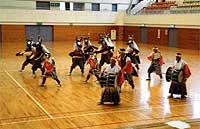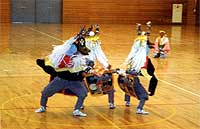
Iwate's Cultural Information Encyclopedia
| Specified type | Prefecture designation |
|---|---|
| Type | Intangible folk cultural property |
| Designated date | September 3, 1996 |
| Specified details | |
| quantity | |
| location | Ichinohe-machine anti-letter Nozaki |
| owner | |
| Holding group | Roots deer dance preservation society |
| Management organization | |
| home page | Ichinohe Town (visiting cultural assets in Ichinohe Town) |
Overview
According to the origin of love, which has been handed down by oral narrative, the Nejika dance has been handed down in the Ichinosemachi Nere area since it originated before the modern age.
Eventually, although it seemed to be lost for a while during the Pacific War, the efforts of the elderly people escaped the interruption and have reached today.
After that, I formed a preservation society in 1975, and after receiving designation of intangible folk cultural property from Ichinohe-cho in 43, I formed a local performing arts club in Ichinohe South Elementary School in 1994, and in 1995 For example, she appeared in the youth traditional arts presentation organized by the prefecture, and a tradition activity where the preservation society and the school were united was developed.
The deer dances in the prefecture are roughly divided into "bakudo" in the central and northern regions of the prefecture and "taikodori" in the southern region of the prefecture.
Among them, the former is distributed mainly in the north of Shinami and Kamishuigun districts, with the hem of a curtain wearing a rhythm and dancing, and representative figures such as "blue dance" and "Hayaike Mine dance" Can be mentioned.
However, it is widely distributed in the method of putting paper zai (hair) on the kanji, and there are not many dance couples who have naive kanuka in the Nichinohe-Kuchinohe region corresponding to the northern edge of this system.
The rebel dance is a representative dance group.
The rebel dance has a rich set of dances for the purpose of the performance and is full of art.
Moreover, there are as many as 36 species of deer dance chopsticks that can be sung now.
(The 4th Intangible Folk Cultural Property Designation Criteria 2 (3))
image

